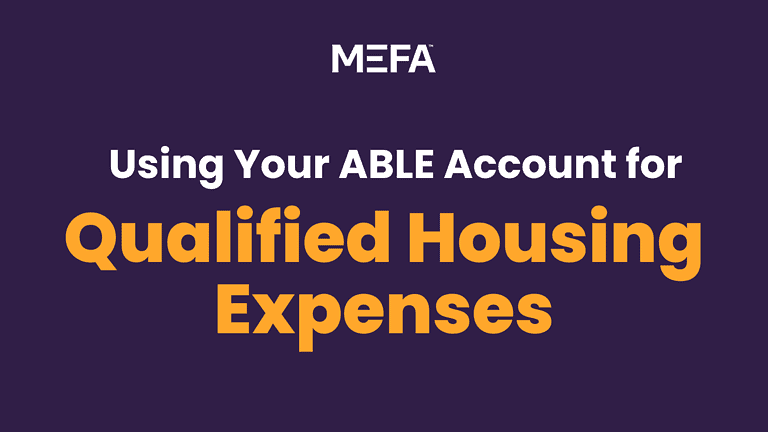With an Attainable® Savings Plan, individuals with disabilities and their families can save for qualified disability expenses while keeping benefits such as Supplemental Security Income and Medicaid. In this webinar, recorded in September 2023, Cynthia Haddad, Certified Financial Planner at Affinia Financial Group, discusses the key features of ABLE accounts and shares real-life examples of how clients utilize these accounts to benefit themselves or family members. Please note that Attainable contribution limits change each year. Refer to our Attainable page for the most up to date limits.
Download the webinar slides to follow along.
Please note that this transcript was auto-generated. We apologize for any minor errors in spelling or grammar.
[00:00:00] All right, welcome and good afternoon. My name is Julie Shields Rina, and I am the director of college Planning education and training at MEFA. And this webinar this afternoon is about able accounts and special needs planning, important tools for individuals with disabilities and their families. And we have two wonderful presenters, Adam Hartwell.
Who manages the attainable program, the Massachusetts ABLE Program at MEFA, and Cindy Hadda, who is from Sequoia Financial Group, uh, formerly Afinia, um, but can tell you about that and I’ll just tell you. A tiny bit about MEFA and then turn it right over to our presenters. But MEFA is a state-based organization that has been around since 1982 and originally started to help families [00:01:00] plan, save and pay for college.
And over the years we have expanded our many offerings, um, beyond college savings plans now to. The Able Plan attainable, which is, uh, for an individual with a disability to be able to save for a wide variety of expenses. So you’re gonna hear all about that. And the other thing I’ll tell you about MEFA is that MEFA offers free guidance on all of the topics, uh, that we’re involved in.
And so you can always reach out to us, connect with us to ask questions, talk things over, and so. Please, please know that going into this. So with that, I’m gonna turn it over to you, Adam, and we’ll go from there. Oh, but let me just say if you need to ask questions during this webinar. Please use the q and a section, um, on, on your, the bar, on your computer.
If you need closed captioning, please hit the live [00:02:00] transcript button and an additional benefit with live transcript. Besides that, you’ll see the words across the screen is you can choose the language, um, that you’d like to see those words in, and other than that, we will. Be record this session and we will be sending you a link to the recording and the slides tomorrow.
So thank you very much. Alright Adam, all. Thank you everyone for being here. Uh, again, my name is Adam Hartwell. Um, so I’m gonna be talking mostly about the, uh, the ABLE Accounts, which in Massachusetts is the attainable program. So the Stephen Beck Jr. Achieving a Better Life Experience or Able Act, amended the federal tax code in 2014 to add Section 5 29 A.
A lot of people are probably very familiar with 5 29 college savings accounts, and that’s kind of the. The skeleton on which, uh, able accounts were built. Uh, whereas 5 29 accounts are for qualified educational expenses. 5 29 A is for [00:03:00] qualified disability expenses. Uh, the established able accounts are tax exempt accounts for eligible individuals with disabilities to be used for those qualified disability expenses while still keeping their eligibility for federal public benefits.
That goes beyond what most people just. Think about it right off the top of the bat, which is things like, uh, the SSI, but also includes things like federal housing waivers in Massachusetts, uh, as each state gets to administer these in their own ways, and they all have different names. So if you wanna open it in another state, you’re gonna find it under another name.
Accounts here in Massachusetts are called Attainable Savings Accounts. So the Atta Attainable Savings Plan was launched in 2017. MEFA is the state sponsor, and Fidelity Investments is the program manager. Fidelity has trained a specialized division to assist individuals with setting up and answering questions regarding their attainable accounts.
So when you go to open an attainable account and you go to their website that you know is uh, fidelity.com/able, there is a phone number on that. [00:04:00] Page that goes straight to this specialized division. If you just Google Fidelity and call up the number that comes up, you’re gonna get their general brokerage numbers.
And a lot of those individuals don’t know a lot or even anything about attainable, so you really want to make sure that you’re reaching out to that specialized group. Uh, for information about setting up these accounts. Uh, the, when it comes to qualified expenses can benefit, um. I apologize, that’s actually the wrong slide, but I’ll talk about it anyways.
These can be utilized for, um, a lot of different purposes of including anything pertaining to health, housing, education, transportation, assisted technology, and assisted technology supports employment training and support and personal support services, as well as basic living needs. Uh, that means that you can pay your rent.
We actually verified that a couple years ago with your attainable account, you can pay for groceries with your attainable account. You pay for your copays, your [00:05:00] medications. You can pay for your Uber, your bus pass. You can buy a car, you can uh, buy a house if you put enough into your attainable, uh, account.
Um, you can use it to buy applications to add to, uh, mobile technology you already owned. Uh, personal support services goes far beyond just, uh, one-on-one community supports. That could also be an accountant or a lawyer, anyone who allows you to live independently. So there is a great variety of access that you can utilize your attainable account for.
At the end of the day, it’s essentially anything that’s not recreation, um, due to the fact that there are a lot of different ways to, you know, apologies. I feel like I’ve actually brought up a educational based, uh. Instead of slides here and I thought I had the other one. And so that, that’s on me and I apologize for it.
Um, Adam, it’s still good information. No, it’s absolutely good information. But, you know, this was. The slides that were developed for a different, uh, presentation and well, you know, I think that I have made a [00:06:00] mistake, but it’s so great information. Oh, you can utilize your attainable account for a lot of different access and planning.
Uh, the, this slide is actually pertaining to the fact that, you know, under the IDEA, the Individual Disabilities Education Act, um. You want to be talking about, uh, financial planning and adult life and transition at age 14. Um, so when you’re talking about, uh, setting up your attainable account, that could be set up when somebody’s born, but it can also apply to anyone across the board.
Um, as long as if you’re gonna be qualified to, uh, for an attainable account, you need to have received your diagnosis before the age of 26, regardless of current age. So if you are 76 now, but you got diagnosed at age 10, you can still open an attainable account, um, in year 2026 on January one. That, uh, age will be changing to the age of 46.
So if you have an acquired brain injury that you got when you were 30, right now you can’t open an attainable account, but [00:07:00] a couple years from now you will be able to, uh, so attainable gives you the opportunity for long-term savings in a lot of different ways, including because education is on the list.
You can use your attainable account to pay for your college education or a trade school or anything that is in career development as far as what your generalized life goals might be.
We talked a moment ago about sort of some of the eligibility criteria. Essentially, you, you also need to be eligible to receive SSI or SSDI or you need to self, uh, certify as meeting requirements, uh, such as with functional limitations such as those on this list to my right here, or the ones on their compassionate allowances conditions list.
Uh, this goes far beyond just developmental disability, but also to mental health and things like long-term cancer recovery. Or, uh, musculoskeletal conditions and so on. And so there’s a lot of different conditions that would, uh, enable you to be eligible for, uh, the [00:08:00] opening, an attainable account. Um, the accounts allow the account owner or beneficiary to save over $2,000, which is the current asset limit, uh, without affecting federal benefits.
I’m aware that there is current legislation that’s being voted on to perhaps raise that to $10,000. Hopefully that does get passed. But regardless, essentially what that $2,000 is right now and $10,000 maybe later, is what is currently considered the entire pie that you’re allowed to have to split up between all your expenses as needed.
What the attainable account would allow you to do is be, have, add a hundred thousand dollars to that account because that’s how much you can have before it affects your SSI. Uh, the full limit would on the account is 500,000. As things are currently said in the year 2023, the, the numbers went up again.
Uh, your annual contribution cannot exceed $17,000. If you are not working. If you are working, you can add an additional $13,590 per year into [00:09:00] that. So a total of 30,590 per year you could put into the account if you are working. Um, there is no, uh, annual account maintenance fee. Um, they are investment accounts, so there are investment portfolio fees that tend to range between 0.57% to 0.94% of assets, which generally speaking is significantly less than the return on the investments themselves.
Provided the beneficiary is the same on both accounts, or one beneficiary is the family member of another, you can transfer funds from a 5 29 college savings, uh, account into an able account without incurring any taxes or penalties. In addition, uh, do the savers credit account. Uh, owners may who meet certain criteria can receive a savers credit on their federal taxes.
Uh, these are, you’re eligible if you’re age 18 or older, are not a full-time student, and are not claimed as a dependent on someone else’s tax return. Additionally, as long as withdrawals are spent on those qualified disability expenses. That blue list we [00:10:00] looked at a moment ago, attainable account growth is federal income tax free.
So if you put money into the account and the investments earn money, those investment, that additional money that you earn does not get taxed as income.
Uh, these are professionally managed portfolios. Um. You can see that regular investments can add up over time if you utilize these as a savings program. Um, we have some examples here of 50, a hundred, $300 per month with a hypothetical example based on historical understandings. We never want to guess what the market might do in the future, but this is based on what the data that we’ve had from the history.
Um, the example that I like to use is that middle one, which is sort of a middle range. All of these are using sort of the middle range of portfolios that are offered. Uh, if you took a hundred dollars and, uh, put it every month, put a hundred dollars into a jar under your bed, uh, you would end up with $24,000.
Um, but with these accounts, you might have something more closer to $46,000 in that account, [00:11:00] given that a lot of the individuals that I, I work with, um, don’t have access to retirement accounts because they are only able to work part-time. This could be what someone could utilize as a way to start saving for retirement as well.
Um, there are eight portfolio options when it comes to an attainable account. One of the things that you’re gonna wanna do is really re research those that they range from, uh, being a full money market account all the way up to having 85% of your, uh, funds in, in the stock market. Um, most, the majority of folk that we serve tend to go for that middle sort of 30, 40, 50% invested zone.
Uh, but you definitely wanna know how much you want, what are those portfolios you want, uh, before where you go through the process of opening an account, because it’s gonna be one of the questions in that co in that course of that event. Um, so one of the things you’re gonna wanna do is go to fidelity.com/able.
That is actually a bounce page. It’s gonna bring you to fidelity.com/attainable/overview. I like to say that just [00:12:00] in case somebody’s got. Doesn’t allow it to, to move, uh, on its own. Uh, so you know where you need to go. Uh, you’re gonna wanna download the disclosure document, that’s their legal disclosure document about attainable accounts.
It essentially has a page written on it about everything I say, a sentence about. And you’re gonna choose those, the, those options for yourself. And you are allowed to change whatever option you pick twice per calendar year. So you could maybe say, ah, things are looking good. I wanna make my account a little bit more aggressive.
Uh, things are, uh, looking a little, I’m a little worried about the market right now. I’m gonna pull back a little bit, make things a little bit more conservative, um, and that’s something you’re allowed to do twice per calendar year. And with that, I’m going to hand things over to Cindy to sort of give an overview of some of the other aspects of special needs planning.
Thank you Adam. I am going to just shortly share my screen. That was a wonderful overview. There’s a lot of information on able [00:13:00] and a, a lot to, to process, so I think it’s, it’s great to have, have the overview and now we’ll talk about ways that I want you to know what able is, um, how we can u utilize it.
We wanna make sure we can, we can utilize it. So if you give me just one minute, I can start sharing my screen with you can, and I’m assuming you can see my screen looks great. Okay, wonderful. Um, are the pictures in the way. Nothing’s in the way. Okay, great, great. So, um, just by full disclosure, I, I am not affiliated with MEFA.
I am not affiliated with, uh, fidelity, um, able attainable account. They’re able account, I am part of the special needs financial planning team, formerly Afinia Financial Group. We just, um, merged into a. Great [00:14:00] team with Sequoia Financial Group. Um, and we’re bringing all of our special needs planning expertise with us, um, to integrate into the Sequoia Financial Group.
We’re still in Burlington, Massachusetts, and we’re still providing, um, the same, um, comprehensive financial planning and wealth management services to families that have, um, a family member or individuals with disabilities themselves. We are also, and there’s my, um, our team is my partner, John Nad, who we’ve been working.
With, for many, many years. And his daughter, Alexandria Nadie, um, she’s also joined our, our team as well. And Julie’s so kind to hold up the, I just wanted to show you that we have your book. Thank you. Thank you. And in our book, uh, one of the. The driving forces for us to update our book was to include information about able.
Our first edition was written in 2007, and one of the biggest changes since then have been including able accounts in our planning. I. But really [00:15:00] what we are talking about in special needs planning is striking a balance, uh, with parents, personal resources, individuals personal resources, and government benefits.
And as Adam had mentioned, if an individual has certain government benefits such as SSI, supplemental security income, they cannot have more than $2,000 of assets in their names. Otherwise they will. Jeopardize their eligibility for those government benefits. Um, but also how do families save for their family member with a disability?
Because it’s really important to make sure that you can save as best you can without disqualifying, um, an individual for government benefits. So what we’re not. Uh, so, and, and we always tell family, parents, you know, put on your own oxygen mask first and make sure your, um, financial planning needs are tended to your goals for your own, uh, short-term, midterm and long-term goals are tended to first, and then we can overlay the needs of your family member.
Um, and, and. Do a [00:16:00] combination of government benefits and personal resources, and then we talk about the five factors of special needs financial planning. Just to frame our discussion for, for now, um, we, we talk a lot about the family and the support who’s who and your family member’s life, um, as it.
Professionals, is it family? Um, and what types of supports are they receiving? It’s also very emotional. So where are you with the emotional acceptance denial? Is it a new onset of a disability? Um, and again, as, as Adam had said, if it’s an onset of a disability. Past age 26, you really can’t use an ABLE account yet until the year of 2026, where that age goes up to age 46.
So there’s sometimes we’re just understanding a diagnosis, um, but we need to have a diagnosis before we can even contribute to an ABLE account. But we also talk in special needs planning about the legal aspects, meaning special needs trust. And alternatives to guard [00:17:00] guardianship and alternatives to guardianship.
Um, we also talk about all the various government benefits that are out there, and of course we talk about the money. So what we’re, what we’re not going to go into all of those other things, but today we’re just really focusing about. The money. And in our special needs planning toolbox, we have different types of savings accounts that allow, uh, families and individuals to put money aside for the future needs of your, your children with and without disabilities.
Um, and, and those are in general, there’s, we have now an able account achieving a better life experience called the 5 29 a plan. We also have, um. Most folks are familiar with a 5 29 college savings account. Um, but. If somebody has, uh, a 5 29 college savings account, they can’t always get that [00:18:00] money out unless it’s for qualifying higher education expenses without jeopardizing their eligibility for that, um, those government benefits that have that $2,000 threshold on it.
But then there’s other custodial accounts that. You know, parents set up, grandparents, set up a uniform gift to minor’s account, uniform transfer to minor’s account. And these are all wonderful tools to save. But once you have to deal with eligibility for government benefits and keeping the that number under the $2,000, it’s tricky, right?
So we often, we don’t wanna discourage people from a financial planning standpoint to make sure that they’re saving. Even if they just save money in the parent’s name, that’s, and use different types of, of savings accounts that we won’t get into today. It’s just really important to start saving and as Adam’s, uh, example, even a hundred dollars a month, just save whatever you can, um, or good ways to gift into, [00:19:00] um, you know, from grandparents or, or parents are using ABLE accounts.
But the most important thing is to start saving. And if you’re not sure if you should open up an able 5 29 or custodian account for a minor child, saving your own name, if you’re the parent, um, or if you’re the sibling like me, um, I, you know, try to save and, and leave money aside for, for my brother. And then we start to get into supplemental needs trust, which, um, is another way to.
Protect eligibility for government benefits. But if it’s a smaller amount of money, an ABLE account is a great place to save money. A couple of things that, just to review what uh, Adam had mentioned earlier is an individual can only have one able account, whereas a 5 29 college savings plan, every grandparent, every aunt and uncle, every parent can set up a 5 29 college savings plan.
Or a custodial account. Those UTMA or UGMA [00:20:00] accounts for an individual, but with an ABLE account, they can only have one. So that means you have to communicate, um, with people that might want to give money for your child or for you as an individual. Um, and the. Really cool thing is that all the savings are tax exempt.
Um, and when you take the money out, if it’s for a qualifying disability expense, it’s not taxable income. So it’s really cool. Um, and some good resources to check out our, the ABLE National Resource Center and able today.org through the National Association of State Treasurers. And they have a nice general overview about.
What, 5 29 a what Able accounts? Um, and each state has a different one. Uh, many of our clients use the Fidelity attainable and are very happy with that. Um, we’re not advocating or promoting full disclosure, um, and any specific one. You don’t need an advisor to, financial advisor to [00:21:00] open up, uh, an able account except for the Virginia, um, ABLE account.
And they have, you have to have an advisor attached to that. But Fidelity and other, um, um, uh, companies that offer able accounts have really well trained staff to help families open up those accounts and answer any questions. But also very important, you have to watch the rules. Um, uh. Uh, making sure that those qual, those distributions are for qualified disability expenses that Adam had a, a nice list there.
Um, the other piece is make sure there’s a known disability prior to the age of 26, again, until, um, 2026, when it can be prior to the age of 46. Um, and then if there’s too much money in the able account over a hundred thousand dollars, your SSI. I may be compromised. Um, and, and certain accounts attainable, the maximum you can have is 500,000.
So the idea with an ABLE account is really [00:22:00] not to transfer a lot of wealth. Again, you can only put in $17,000 per year, and if you’re employed, you can add that up extra 12,000 plus. Um, but it’s really a. Good way to save some money, have some flexibility, and pay for certain expenses upon the death of the beneficiary, whoever you opened up the ABLE account for.
Um, even though during their lifetime they put money into the ABLE account so they could keep their eligibility for. Government benefits including Medicaid, which if you’re on SSI automatically gets you Medicaid benefits aid, not Medicare, but Medicaid. So upon the death of the beneficiary, Medicaid can can do a clawback and they can say, okay, we’ve been providing all these, these funding all this time, so we’re entitled to what’s remaining in that ABLE account.
So a traditional third party special needs trust, you could put more than the 17,000 a year in, but there’s [00:23:00] no Medicaid payback on a traditional common third party special needs trust. So something very important is to look at that, you know, beneficiary. Um. But some tip tips and strategies. Um, one of the big win-wins with having money in an ABLE account is that able account funds can be used for housing, um, and it won’t offset, um, the amount that an individual would receive for SSI, for example, when somebody’s living at home with their parents, their parents are considered to be providing.
In kind supports and services. So they get a reduced SSI check. Um, and we’ve had. This, um, happened is a perfect example of a parent who bought a condominium for their child and he received his SSI check and did whatever he wanted with it. Mom and dad were paying for the taxes on the condo. They were [00:24:00] paying the condo fee, and they were really doing a great job for their son, and he got to do whatever he wanted with his SSI.
In their planning. Then when they called me, it was because they, their son kept getting a reduced amount of SSI and I kept thinking, well make sure he’s paying you rent. So they had him pay a little bit of rent and I, what I didn’t know is that they were paying for all these other expenses. So Social security, SSI.
Said, well, the parents are providing in-kind support and maintenance. The kid’s not paying for any of his housing, so he doesn’t need as much in his SSI check. Finally, he lost his SSI income. So what we did the go around able to the rescue and we were able. To have the parents put in $17,000 a year into the ABLE account and they pulled from the able account to pay for his housing expenses because that rent, his SSI check would not cover that amount of rent for the condo.
It’s in a beautiful area. [00:25:00] Um, would be the fair market. Rent that he would pay anywhere else. So we were able to use the able account, able to able, um, to pay for his housing expenses and then he was able to get back onto SSI at a full, um, about $700 a month receiving SSI income to help him pay for his housing.
So it was a great tool to use. Also, if there is a supplemental needs trust or, uh, you can use some of the money from the special needs trust and fund an ABLE account. So, and that ABLE account can be used again for housing, whereas in a. Certain types of special needs trusts, you can’t pay for housing because they’re supposed to supplement what the government will provide.
So if the SSI is government benefits paying for, um, housing, well then you can’t supplement with the supplemental needs trust for housing. But an ABLE account can certainly supplement. [00:26:00] So it’s a great tool work around for housing. So when you have questions about housing, um, or any. You know, talk to the folks at Attainable and um, maybe about.
Um, using ABLE funds to pay for housing expenses. Um, another cool strategy with ABLE is if somebody has a 5 29 college savings plan account, and then we find out. You know, mom and dad did a great job starting at a young age. They set up a 5 29 college savings plan account before there was any known di diagnosis of a disability.
And then around age 1415, they’re thinking, gee, we’ve got all this money in a 5 29. It doesn’t look like Johnny’s gonna go to college. Um, could he go to a trade school? And we could use that money absolutely. But. He’s not gonna go to any continuing education, um, after high school. [00:27:00] So what do they do with these 5 29 plan money?
If they take it out of the 5 29 and they don’t use it for education, it’s, there’s a penalty, tax penalty plus it’s taxable. So what we were able to do for Johnny was we were able to transfer $17,000 per year into an ABLE account, and we were chipping away. At that 5 29 College savings plan account, before you knew it, he was 18, 18 years old, and we had depleted his 5 29 pretty much, and he could go and apply for SSI and not worry about it with a balance that was still in that 5 29 plan.
We moved it to his brother, it’s 5 29 college savings plan tax free. And it didn’t disqualify him for his government benefits. So there’s ways to work around if parents have. Been great or grandparents have been great about saving in 5 29 college savings plans and flipping them over to able [00:28:00] accounts.
And then, you know, we have distributions for qualified charitable, um, qualified, um, disability, disability expenses. And those are the key points that I wanted to make, um, about able, we have a whole bunch of information in our book, more details, and also, um, our [email protected]. We have a whole bunch of FAQs about able as well, but I encourage you to tap into mi a.
Um, there are a great resource of, um, all sorts of anything able. Um, so with this, I’m gonna pass. The baton back and maybe we can talk about some cases and, um, any, any questions. And I, and I also, I just wanted to sort of, since we have a little bit of extra time, I wanted to build on some of the things that you brought up there, if you don’t mind.
Um, one of the big things, one of the biggest concerns that we see a lot of is that whole claw clawback thing, [00:29:00] right? The, the repayment stuff that happens. Um, and we, uh. Consulted around a little bit, and I’ve read in several places and several people I’ve trusted have, uh, have indicated that it looks like that actually really wouldn’t apply if you had less than $25,000 in the account.
Um, additionally, there are several waiver programs that exist that can also help you get around that limitation. Um, but one of the biggest things I like to point out is the fact that, um, after someone passes, uh, the account is frozen for 12 months until all actions on the account have been completed. I.
And, uh, that includes any outstanding qualified disability expenses. So that includes all, any hospital bills that took place while the person was passing on and their burial and funeral expenses. And that can deplete the account pretty much entirely just right there. So all of that happens before a Medicaid takes its swing.
So, um, there it’s not as big a concern as I think a lot of people, uh, believe it [00:30:00] might be, uh, going into that whole process. Um, another really great usage of the account that, um, you know, just we have a little moment here that you can do with it is that if you can save up enough to cover all of your bills for three or four months, that’ll take you a minute.
Sure. But you know, if you can, uh, if you can save up enough to, to cover your bills for a couple of months, if you have someone who’s really wanting to try working full time but hasn’t been allowed to because of that income limit, I can only work less than 25 hours a week. Is a big thing that we hear all the time.
Um, if someone was to save up enough for a couple months of expenses, they could try working full time. Um, and if it’s successful, they can work full-time. Fantastic. They still have an able account with that money in it to, you know, that they can use for their needs along the line as they go. If it doesn’t work, they now have a buffer to make sure all their bills are paid while they get SSI reestablished.
And if that’s within 12 months, that won’t be a problem to have happen. So it gives [00:31:00] people an opportunity to say, I think I can do this. I think I can be fully independent. I can work a full-time job, and able gives you the opportunity to make that, uh, uh, that opportunity a reality. So there’s a lot of, that’s a great one that you can sort of go around things with it, um, as things go along.
You. That’s a great one. You know, we also, um, gifting from grandparents, right? Aunts and uncles, gifting ev you know, people want to give to all the grandchildren or the nieces and nephews and all well intentioned. And I can’t tell you how often I hear people say, I wish my father-in-law would stop giving all my kids money because I don’t know what to do with Johnny’s money.
Right. And now we can say. Put it in able account and grandparents are so excited about being able to gift 5 29 college savings and then 5 29 a able account for the child that we’re not sure, or they are already receiving government benefits, but they might be doing some estate tax planning. So [00:32:00] gifting is great, but if they didn’t, um, you know, if.
Grandparents, aunts, uncles, or just people in your child’s election and they’ve included someone with a disability to receive a portion of their inheritance. Yep. You know, maybe it’s, you know, $12,000. It’s, it’s not enough to make a huge difference in their life, but it’s enough to knock ’em off some of those benefits.
It’s, that’s where able to the rescue, right? We, we had a situation where an, an aunt had included their child, um, in her inheritance, which was so thoughtful and obviously the aunt was thought just being thoughtful. Um, but it was quite a bit of money and we could have either gone through the pa it was about $35,000 I think.
Maybe not quite a bit of money, but it was enough money that we couldn’t put it all into an able account at once. But what we were able to do is have the personal [00:33:00] representative of that estate put money, 17,000 in in year one, waited 12 months and put the next 17,000 in. And so we were able to. Protect that inheritance.
Um, whereas an attorney had said, oh, you better disclaim that inheritance. You know, just, just give it away. Don’t take it. We were able to use that, able as a way to receive the funds. We didn’t have to spend a couple thousand dollars of the money to set up a special needs trust. We didn’t have to go to a pooled trust.
We just were able to use able, and that individual is just thrilled to be able to have that tool. And years ago we wouldn’t have had that. And, and it, and it also gives you, um, some really wonderful disaster planning because again, you know, just once again, as far as like, you know, uh, I need a surgery that’s gotta be out of pocket, right?
And I wasn’t allowed to save money prior, right. Or I found out about a specialist that I would like to, uh, go to because I think they can help me a lot with whatever my condition [00:34:00] is. But that specialist lives a hundred miles away from me. I need to move. Again, housing is a, uh, qualified attainable expense.
So, okay, that’s another thing that would, you know, once again, you can be able to do that. Or again, we’re talking about that $2,000 pie. If you’re trying to pay all your bills outta that $2,000 pie and you’re allowed to have one car without it affecting your SSI benefits, but what kind of car are you gonna have with what’s left over after you’ve paid all your bills?
If you only got $2,000? You know, attainable can give you the ability to maybe have a car that’s not gonna cost you a thousand dollars in repairs every week, because you’re That’s right. A little bit better for long-term planning, you know? Mm-hmm. It’s, it’s a better pair of boots idea, you know? So there’s a lot of fun, fun ways where attainable isn’t, you know, a silver bullet to solve all problems, but it can help with a lot of them.
And we actually have a question. Um, and I think someone’s very happy, um, to be beyond this webinar, um, because their family paid out of pocket where they now [00:35:00] see they could have used an able account for something. So there is a question, however, um, is there a way to transfer traditional savings such as in an IRA to an ABLE account, um, as future expenses come up, so, so that she could take advantage of an ABLE account.
Yeah, pulling money out of an IRA is taxable. Yeah. Um, if it’s the individual’s IRA account, um, we might be able to get a, a, a wraparound from IRS to avoid the 10%, you know, prepay, early withdrawal, um, distribution, tax, you know, penalty. Um, but it’s still taxable to the individual. Yeah. So maybe, you know, we could look.
Possibly converting it to a Roth IRA, but it’s hard to get it direct. You can’t go direct from IRA to Able. Yeah. Um, but there’s some workarounds that, that you can think [00:36:00] about. Um, yeah. Doing and if it’s a parent’s IRA to go to an able, I would probably just use regular savings. And put that into the ABLE versus taking money out of an ira.
And remember what I had said earlier is make sure you take care of your own financial needs, right? Parents? So we, we discourage parents from taking money out of their retirement plans for paying for college tuition for their kids. So same thing we would discourage from taking out of your own retirement bucket of funds.
Follow. Adam, you wanna say a little bit about, um, just how, how easy it is to open an ABLE account and so that maybe these folks could start now? Um, just opening with, with small amounts, you know? Oh, yeah, yeah. You. So, two things I wanna say on that. Well, first off, you know, opening an ABLE account is, you know, very simple process.
You go to [00:37:00] fidelity.com/able, uh, and you’re just gonna follow the prompts to open it up. Uh, you do wanna make sure that you have, uh, discussed with your, with any financial advisors you might have. Which level of portfolio you wanna sign up for? One of the big things is, is whoever signs up the account, whoever creates the accounting, is going to be in control of the finances, is what we call a person with signature authority.
That’s the person who’s going to be in charge of the account. And, um, a place where we have seen some people create, um, an, you know, an accidental hassle is where they, uh, think, ah, this is four. My, my child, you know, we, I’ll use Johnny for, for Cindy here. For Johnny. So Johnny is not legally competent. But I’m making this bank account for Johnny, so I’m gonna do everything in Johnny’s name and fill out everything for them.
And then when it comes time for Johnny to do anything, because Johnny’s not legally competent, uh, it creates, uh, Johnny should not, is always gonna be considered the owner of the account, [00:38:00] but the owner of the account and the person with signature authority don’t have to be the same person. So, you know, the beneficiary is the owner.
That’s always the individual with a disability. But the individual disability can also be the person with signature, uh, uh, authority. The person who opens and controls the account, or can be a parent, a spouse, a rep, payee, a guardian, um, a power of attorney. So if there’s somebody who you really feel is going to be making the financial decisions, they should be the person who’s listed as a person with signature authority.
Um. So, uh, but yeah, that’s all part of that just set up process. Uh, one of the things we also run into is some people. Aren’t sure exactly how to get the money back out after they put the money into these accounts. Um, you can transfer money from an attainable account into any bank account you want or any bank you want can, you can take it in.
But one of the things that we’ve taken to recommending, ’cause it just makes life easy, is at the same time, since you’re already filling out a bunch of paperwork with Fidelity, is to open what’s called a Fidelity cash management account, which is essentially a bank account with Fidelity. And if you do that, then [00:39:00] you can use Fidelity’s app and just.
Transfer money directly over quick and easy. You don’t have to wait five business days for the other bank to receive it and what have you. And that account comes with a Visa logo de debit card, so you can transfer it and then be able to swipe the card. Makes life very easy for, for people to be able to do their spending without a big challenge.
I do wanna address that in the. The, uh, question, uh, some of the things that were mentioned are absolutely covered. Uh, you know, uh, things having to do with, you know, wheelchair, health and transportation are both in there. So, uh, one of the things, examples I often use is like, even the, the motor on a wheelchair van.
It requires annual maintenance, that’s like $1,200 at minimum. So there’s a lot of things that are incidental expenses that attainable can help someone not have to be worried about how, you know, spending part of those assets on that you can use to, to make sure that these are successful usages. Sounds great.
So, great. Well, you two have, [00:40:00] have covered, um, so many important pieces about. About attainable and about how it all fits into a larger picture of working with a family. Um, I don’t know if you have any other. I know when we’ve spoken in the past, Cindy, you’ve had some, you’ve had, you’ve had a lot, you have a lot of examples of working with families.
I don’t know if there’s one that we haven’t covered that you wanna share. Um, but if not, um, I don’t see any current questions and we can No, I think, Adam, you, you covered a whole bunch of stuff and I think that, um, one thing that folks need to remember if they do, and, and the nice smoothness of that.
Fidelity app. People really like that. But just remember, if you move the money over into the cash manage account, you, you have a month to, to spend it, otherwise it’s counted, um, against, against you. Yeah. And, and then the di I’m sorry, just before I forget it. Yeah, because you said it. There is a special rule when it comes to qualified disability expenses when it comes to housing, [00:41:00] that that has to be used within the same calendar month.
Right? So one thing where people get tripped up is they take money out on the 30th to pay their rent on the first. Then they, they, they get dinged because of the housing. Oh, right. So, yeah. You know, pay it, pay it the day early on the 30th. So you take it out and use it in the same calendar month, so you don’t get that trip up happening.
Yeah, exactly. I think that, yeah, really good point. Really good point. But it also allows individuals with disabilities to have savings and, you know, they have goals of maybe not a new car, but, you know, they might wanna, um, you know, have a, a, a, um. A support pet, a support animal. Sure. And, you know, that’s something that they might wanna save for.
Um, so there’s certain things that people with disabilities do need and do want, and there’s lots of workarounds and able gives them that opportunity. And on the support, uh, you know, the, the, you know, the support animal, the, the, you know, uh, level, um, [00:42:00] those, uh, animals are, you know. Thousands of dollars and they require an additional many thousands of dollars to train.
And a one-to-one professional that I think would absolutely be a qualified expense would be the training professional to make sure that, you know, you have a dog that I can identify when your diabetes is acting up or when your seizure is coming on, or you know, if you are about to have an elopement into a road.
All things that I have done things with support dogs. Um, and, you know, so there’s a lot of, uh, of value there, uh, that can be found. Uh, and, uh, again, you know, you, if we think about the qualified disability expenses, um, and how that’s not recreation, right? Right. Um, before you, once again gonna use my pie example, we had that $2,000 pie for all of your needs and anything you wanna do that’s fun, right?
If we’re able to, you’re able to put enough money into your attainable account that you can cover all the things that are needs. You’re [00:43:00] using your attainable account to cover that, then the $2,000 can become your savings for things that are purely recreational. Instead of having, I can, I, I can save $20 this month to, you know, go to the movies.
Alright. Okay. I would like to take a vacation. Um, and instead of saying, I’ve gotta take a vacation that costs $20, alright, all my needs are being, you know, utilized in my attainable account. I can now save up to the $2,000 in my generalized checking account to be able to do something extraordinary to make, give myself greater life satisfaction.
You know, I, when I was, uh, I, you know, I was in in direct services for over 20 years. I had a, a gentleman that I worked with, great guy. In his seventies who, uh, we took him to his first Red Sox baseball game at 74. Oh. Lifelong fan Living in Boston had never been able to have that opportunity. And so those are the things that we can, you know, give people the space in their finances to be able to, [00:44:00] to experience.
That’s cool. I know we have, we have one last question. Um, is there a household income maximum that qualifies a parent or guardian to open an account or get assistance? That’s a good one, Adam. Um, what I think they’re asking is, is there a, a limit that the household can be making to, uh, where wherein they, they’re no longer allowed to open an ABLE account and that actually doesn’t apply to attainable.
What it does apply, it applies to whether or not you’d be perhaps receiving certain amounts of funds from SSI, but it’s not going to change the individual having a. Is the eligibility requirement for having an attainable account. So, you know, once again, you could be, you know, let’s say both your parents are doing, you know very well, they make 500 million a year or something like that.
You know, the kid isn’t, uh, in that same circumstance, probably Johnny isn’t making that 500 million a year. Johnny can absolutely have an attainable account. [00:45:00] Uh, you know, again, you are limited to the $17,000 per year in contribution and with an additional 13,590 if you’re working. Um, and I do like to just make the little note that you’re only allowed to have your workplace direct deposit, the initial $17,000.
If you wanna put the additional 13,590, you need to cash that independently and deposit it yourself. Um, also just to note, because we’re talking about it, SSI is only allowed to be direct deposited to a single space. So if it goes into your, uh, attainable account, you can’t split it. So if you do want those, that that monies to be split, you need to deposit into your generalized bank account and then shift over the amount into your attainable, which is again, another good reason perhaps to use a cash management account because.
Making that very easy. And just a final note, because Cindy reminded me of it about when, with her statement about the back and forth with the, the swiping. Uh, it’s a contribution limit. So if you take a hundred dollars out and put it in, take it out, put it in, take it out, put it in, you can use up your [00:46:00] entire $17,000 with the same a hundred dollars going back and forth.
So take out money. Use it, uh, would be, would be the, so take out what you feel you’re going to need to use, um, and, and be, be considered about that process. And there is one I said last, last, but there is one more question, and I’m not sure I know that. Um, but I, you, you may know the answer to this. What is the income cap for SSI do we, would you know the answer to that?
I should know the answer to that. Correct. Um. You can, if you go on to um, ssa.gov, I should know the, I should know that. I don’t have that off the top of my head. Gov. I’ll put, I’ll type the answer. SSA gov should give that answer. Yep, that’s good. And, you know, a lot of that’s based in the poverty guidelines.
It’s actually the same reason for, you know, every year, uh, generally the, that, that, uh, work-based income [00:47:00] amount goes up as well. Mm-hmm. And that’s because that 13,590, it’s a weird number that is based on the, on the federal poverty guideline numbers. Right? That’s why that goes up each year as, as inflation is determined and what have you.
Um, so yeah. Uh, that, that’s where that tends to come from. Yeah. Just to know. Qualifying for SSI, right. Once an individual’s age 18, prior to age 18, a family may qualify for SSI supplemental security income, so that’s where the. General poverty guidelines are on SSA doco, but once that individual turns age 18, it’s based on their own assets and their own income.
Nothing to do with the parents, but you need to be, by the definition of the social securities disability definition, um, you know, not being able to be gainfully employed, the disability is, is, you know, going to last, you know, longer than 90 days or long a lifetime. And, um. You, you need to [email protected] to see those definitions of what the [00:48:00] disability, um, may entail.
That’s what’s the definition of a disability, so you have to look and dig deep. I mean, some parents will say, well, my kid has anxiety disorders. Well, you gotta dig it further. Or they’re on the spectrum where you dig it a little bit further on ssa.gov. Thank you and you, and then the, the all good questions.
Yeah. Yeah. The, the, the slang within s uh, the, the SSA that we’re looking for, there is significant gainful activity. The SGA is, is how we determine, uh, how much they’re able to contribute to the household. And that’s also where that whole household SSI reduction comes in for inkind support and maintenance.
All these things are delightfully interrelated.
Well, I just wanna say thank you both so much. I think you’ve shared so much great information and thank you for the terrific questions that we’ve received. And, um, please be in touch with us, um, and share this information and, and be in touch if you have further questions. [00:49:00] And we will. Um, I’ll wish you all well and we’ll see you soon.
Alright, thanks Julie. Thanks Adam. Thank you. Thank you.













